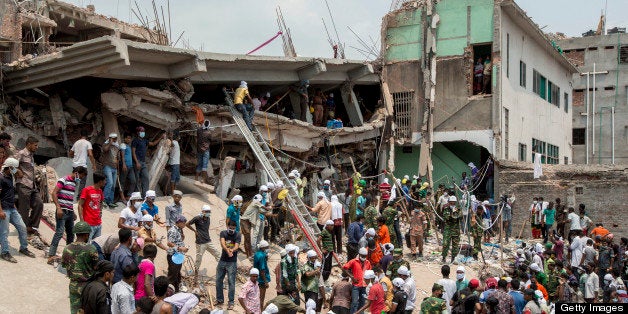
The collapse of a large eight-story garment factory in Savar on the outskirts of Dhaka a few days ago has resulted in numerous images, stories and reports. The loss of more that 300 lives, most of them young parents, alongside the countless number that have suffered serious injuries, has resulted in immeasurable pain, suffering and anger.
Unfortunately, this is not the first time that the spotlight has been directed on the garment industry in Bangladesh. Nearly 1,000 lives have been lost apparel sector factories in the country over the last five years. Just last November more than 112 lives were lost in the Tazreen factory fire. One report on that catastrophe pointed out that not only were their inadequate fire extinguishers throughout the building but the fire equipment was not able to reach the site because the access road was not wide enough.
This time we are told that the factory was built without the necessary permits because it often takes too long to acquire such permissions so some short cut solutions were pursued. It has also been reported that while cracks in the building walls and structures were identified by some of the workers the day before the collapse they were compelled by their supervisors and employers to return to their work stations on the day of the disaster.
At the macro level we are told that 80 percent of the annual $24 billion export earnings for Bangladesh comes from the garment sector. There are few jobs around for the countless young people in search of employment and this sector provides numerous start up positions for young and eager workers. Rising wages in Chinese factories have pushed manufacturers and suppliers to search in places like Bangladesh for a cheaper labor source, a diversified supply chain, cheaper clothes for shoppers, greater profit margins for companies and better returns for investors.
How many young lives will it take and how many orphaned children must be counted before we are shamed into addressing this broken business model that we both ignore or have pretend not to exist for decades nigh centuries. How can we continue to take comfort in the very small and incremental steps and processes that have been put in place to improve salaries, to safeguard workers and to protect the environment?
Labor, raw material and capital have been inextricably combined for centuries to bring products and services of all kinds to the market. The process has provided jobs for those who needed income and opportunity for those who dreamed of escaping otherwise dead end situations and products and services to thousands who might otherwise not be able to afford them. It has however also resulted in human bondage and slavery, hardship, loss of life or limb, irreversible damage to personal health and community well being and the environment.
The model is broken and needs to be fixed. Each of us needs to put our shoulder to the wheel, our courage to the task and our calculators to the measurements and ratchet up our sense of solidarity with the victimized and their families. This system has been allowed to continue for far too long and many of us are complicit in it.
We are not talking here about sweat shops filled with child labor, overworked employees and practically indentured servants, though in some instances those circumstances still exist. We are talking about a system that we have come to participate and rely on to purchase cheap clothes and footwear from season to season. We are talking about most of the brand names and retailers that you and I have frequented for decades.
Sure, we have established and supported the Clean Clothes Campaign, Shop with Meaning, the Fair Trade Clothing, etc., but these have barely dented the reach and depth of this industry and its business model. While commendable and sound, they are not enough and never will be to address the systemic nature of this fundamental lack of respect for human dignity and human life.
It is time for renewed and concerted action. We need to demand a solution that will require a contribution from governments, regulators, industry leaders and politicians, shareholders, customers, clients and communities. We don't need to shut the industry down or close all the factories or stop shopping. We do need to find out and decide what it takes to put the unscrupulous and greedy factory owners and suppliers, businesses and their leaders, out of business and replace them with those who are committed to brining integrity to the business model and supply chain.
This will not be accomplished overnight. Entrenched interest that run the gamut of the supply chain from growing raw material to the customers to the investors to those who establish and monitor the rules for this industry have a responsibility. It can range from a conversation or letter with an elected official or the manager of your nearby retailer. It includes deciding which retailers to patronize, or how much more you may be willing to pay for an item as the cost for comprehensively addressing the horrible conditions that have lead to this catastrophic but avoidable disaster.